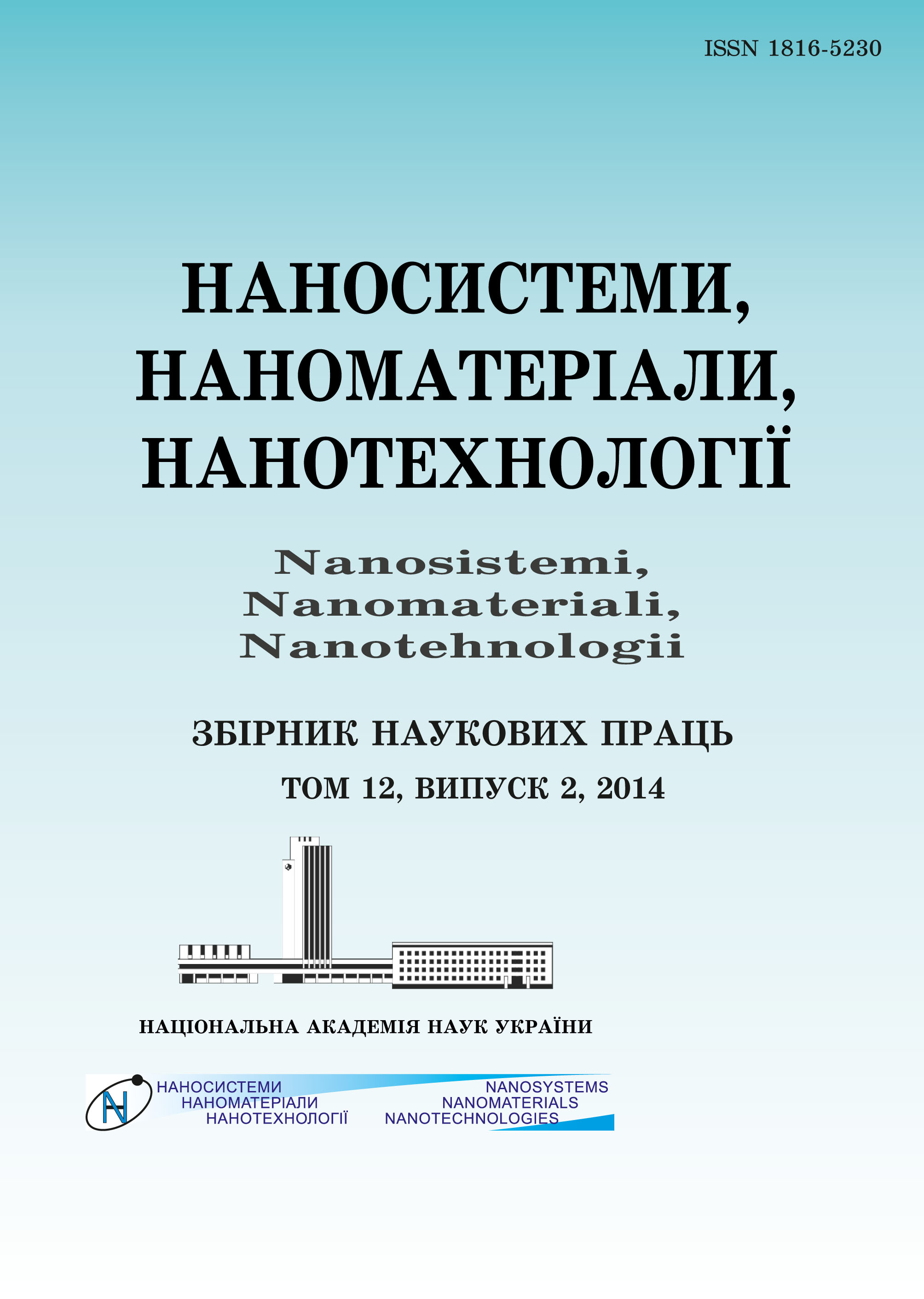|
|
|||||||||
 |
Year 2023 Volume 21, Issue 4 |
|
|||||||
|
|||||||||
Issues/2023/vol. 21 /Issue 4 |
Î. Ya. ÎMELCHUK, D. M. NOZDRENKO, I. M. VARENIUK, O. P. MOTUZIUK, K. I. BOGUTSKA, V. M. SOROKA, I. V. MISHCHENKO, and S. V. PRYLUTSKA
Evaluation of the Level of Low-Density Lipoproteins in the Blood of Rats with Rhabdomyolytic Renal Failure of Various Severity Degrees and Water-Soluble C60 Fullerenes Action
909–921 (2023)
PACS numbers: 81.05.ub, 82.39.Rt, 83.80.Lz, 87.19.Ff, 87.19.rh, 87.19.xn, 87.85.Rs
The effect of water-soluble C60 fullerenes (C60) at different doses of intraperitoneal administration (1 and 2 mg/kg) on the development of rhabdomyolytic renal failure of various severity degrees (introduction of 50% glycerol solution intramuscularly into the muscle soleus in doses of 5, 10 and 15 mg/kg) is evaluated during 3, 6 and 9 days of the experiment. It is established that the greatest therapeutic effect in reducing the fractional excretion of sodium occurs, when using the C60 aqueous solution at a dose of 2 mg/kg on the 9th day after the development of rhabdomyolysis. As shown, the injections of the C60 aqueous solution at a dose of 1 mg/kg reduce the content of low-density lipoproteins (LDL) in the blood of rats by 13–18% on average, and increasing the dose of C60 aqueous solution twice (2 mg/kg) contributes decrease in the LDL level only in severe stages of rhabdomyolysis. This is confirmed by histopathological analysis of kidney tissue (a decrease in the degree of tubular and interstitial necroses as well as of renal glomeruli retraction is observed). The Ń60 therapy proposed for the first time for this pathology opens up new perspectives for clinical research.
Key words: rhabdomyolysis, renal failure, low-density lipoproteins, pathohistological analysis, muscle soleus, C60 fullerene.
Issue DOI: https://doi.org/10.15407/nnn.21.04.909
References
- N. Petejova and A. Martinek, Crit. Care Lond. Engl., 18, No. 3: 224 (2014); https://doi.org/10.1186/cc13897
- J. Wu, X. Pan, H. Fu, Y. Zheng, Y. Dai, Y. Yin, Q. Chen, Q. Hao, D. Bao, and D. Hou, Sci. Rep., 7, No. 1: 1 (2017); https://doi.org/10.1038/s41598-017-10693-4
- J. Barasch, R. Zager, and J. V. Bonventre, Lancet, 389, No. 10071: 779 (2017); https://doi.org/10.1016/S0140-6736(17)30543-3
- F. E. Nielsen, J. J. Cordtz, T. B. Rasmussen, and C. F. Christiansen, Clin. Epidemiol., 2020: 989 (2020); https://doi.org/10.2147/CLEP.S254516
- Sh. A. Al laham, Braz. J. Pharm. Sci., 54, No. 1: e17442-1 (2018); https://doi.org/10.1590/s2175-97902018000117442
- I. B. Colina, Ŕttend. Phys., 1: 63 (2012).
- N. D. Vaziri, Am. J. Physiol. Renal. Physiol., 290, No. 2: F262 (2006); https://doi.org/10.1152/ajprenal.00099.2005
- I. B. Colina, U. Stavrovskaya, and E. M. Shilov, Ter. Archive, 76, No. 9: 75 (2004).
- C. K. Abrass, Am. J. Nephrol., 24: 46 (2004); https://doi.org/10.1159/000075925
- M. Heloisa, M. H. Shimizu, T. M. Coimbra, M. de Araujo, L. F. Menezes, and A. C. Seguro, Kidney Int., 68, No. 5: 2208 (2005); https://doi.org/10.1111/j.1523-1755.2005.00677.x
- T. I. Halenova, I. M. Vareniuk, N. M. Roslova, M. E. Dzerzhynsky, O. M. Savchuk, L. I. Ostapchenko, Yu. I. Prylutskyy, U. Ritter, and P. Scharff, RSC Adv., 6, No. 102: 100046 (2016); https://doi.org/10.1039/C6RA20291H
- C. A. Ferreira, D. Ni, Z. T. Rosenkrans, and W. Cai, Nano Research, 11: 4955 (2018); https://doi.org/10.1007/s12274-018-2092-y
- T. Halenova, N. Raksha, O. Savchuk, L. Ostapchenko, Y. Prylutskyy, U. Ritter, and P. Scharff, BioNanoSci, 10: 721 (2020); https://doi.org/10.1007/s12668-020-00762-w
- Yu. I. Prylutskyy, I. V. Vereshchaka, A. V. Maznychenko, N. V. Bulgakova, O. O. Gonchar, O. A. Kyzyma, U. Ritter, P. Scharff, T. Tomiak, D. M. Nozdrenko, I. V. Mischenko, and A. I. Kostyukov, J. Nanobiotechnol., 15: 1 (2017); https://doi.org/10.1186/s12951-016-0246-1
- D. M. Nozdrenko, T. Yu. Matvienko, O. V. Vygovska, K. I. Bogutska, O. P. Motuziuk, N. Y. Nurishchenko, Yu. I. Prylutskyy, P. Scharff, and U. Ritter, Int. J. Mol. Sci., 22, No. 13: 6812 (2021); https://doi.org/10.3390/ijms22136812
- D. Nozdrenko, T. Matvienko, O. Vygovska, V. Soroca, K. Bogutska, A. Zholos, P. Scharff, U. Ritter, and Yu. Prylutskyy, Applied Nanoscience, 12: 467 (2022); https://doi.org/10.1007/s13204-021-01703-z
- H. Trillaud, P. Degr?ze, C. Combe, C. Demini?re, J. Palussi?re, S. Benderbous, and N. Grenier, Magn. Reson. Imaging, 13: 233 (1995). https://doi.org/10.1016/0730-725X(94)00114-I
- N. Candela, S. Silva, B. Georges, and C. Cartery, Ann. Intensive Care, 10, No. 1: 27 (2020); https://doi.org/10.1186/s13613-020-0645-1
- K. I. Bohuts’ka, Iu. I. Pryluts’ky?, and D. M. Nozdrenko, Fiziol. Zh., 60, No. 1: 91 (2014).
- D. N. Nozdrenko and K. I. Bogutska, Biopolym. Cell, 21, No. 3: 283 (2005) (in Russian); http://dx.doi.org/10.7124/bc.0006F3
- S. V. Prylutska, I. I. Grynyuk, K. O. Palyvoda, and O. P. Matyshevska, Exp. Oncol., 32, No. 1: 29 (2010).
- Yu. I. Prilutski, S. S. Durov, V. N. Yashchuk, T. Yu. Ogul’chansky, V. E. Pogorelov, Yu. A. Astashkin, E. V. Buzaneva, Yu. D. Kirghizov, G. V. Andrievsky, and P. Scharff, Europ. Phys. J. D, 9, Nos. 1–4: 341 (1999).
- N. Gharbi, M. Pressac, M. Hadchouel, H. Szwarc, S. R. Wilson, and F. Moussa, Nano Lett., 5: 2578 (2005); https://doi.org/10.1021/nl051866b
- S. V. Prylutska, A. G. Grebinyk, O. V. Lynchak, I. V. Byelinska, V. V. Cherepanov, E. Tauscher, O. P. Matyshevska, Yu. I. Prylutskyy, V. K. Rybalchenko, U. Ritter, and M. Frohme, Fullerenes, Nanotubes and Carbon Nanostructures, 27: 715 (2019); https://doi.org/10.1080/1536383X.2019.1634055
- Âancroft’s Theory and Practice of Histological Techniques (Eds. S. Kim Suvarna, Christopher Layton, and John D. Bancroft) (Elsevier: 2019).
- U. Khalid, G. Pino-Chavez, P. Nesargikar, R. H. Jenkins, T. Bowen, D. J. Fraser, and R. Chavez, J. Histol. Histopathol., 3: 1 (2016); https://doi.org/10.7243/2055-091X-3-1
 This article is licensed under the Creative Commons Attribution-NoDerivatives 4.0 International License ©2003—2023 NANOSISTEMI, NANOMATERIALI, NANOTEHNOLOGII G. V. Kurdyumov Institute for Metal Physics of the National Academy of Sciences of Ukraine. E-mail: tatar@imp.kiev.ua Phones and address of the editorial office About the collection User agreement |